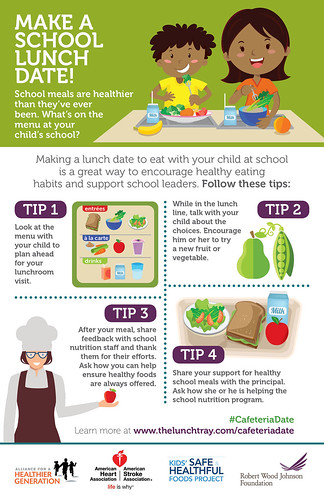
More than 50 million children around the country attend schools that participate in USDA’s National School Lunch Program and School Breakfast Programs. And not only are their meals full of nutritious ingredients – with 99 percent of schools nationwide reporting that they are successfully meeting the updated nutrition standards – their entire learning environment fosters healthy habits now and throughout the rest of their lives. During National School Lunch Week 2016, USDA and partners like the Robert Wood Johnson Foundation, are celebrating this progress.
It’s National School Lunch Week and this year we have more to celebrate than ever before!
Over the past decade, significant policy changes have sparked a national movement that has transformed the school nutrition landscape and created a new healthier era for school foods. Many of these policies were initiated by USDA, including updated nutrition standards for the meals and snacks schools offer, as well as updated requirements for local wellness policies.
Thanks to these developments and incredible efforts by schools to put them in place, millions of students across America not only have healthier meals, snacks, and drinks at school – they’re also learning healthy habits that will last a lifetime.
Polls and research show that parents and students are on board with these changes. And this month, the Robert Wood Johnson Foundation is encouraging parents to make a date to have lunch with their child at school and talk about healthy food choices together!
At RWJF, we’re committed to ensuring that all kids—no matter who they are or where they live--have the opportunity to grow up at a healthy weight. Schools are central to that vision.
Every school day more than 31 million kids receive meals through USDA’s National School Lunch Program. Right now, 98.5 percent of schools meet USDA’s updated standards and nearly half of states are at 100 percent compliance. Studies show that school meals are healthier, kids enjoy them, and are eating more of them. Research also shows that many kids consume up to half of their daily calories at school, so what’s available in the cafeteria, vending machines, and school stores really matters!
This is especially true for our nation’s most vulnerable children, including those who live in poverty and truly depend on school breakfast, lunch, snacks or afterschool supper to meet their daily nutrition needs. It may be hard to imagine, but for many kids whose families can’t afford or lack access to healthy foods, schools may be their only source of fruits, vegetables, or fresh wholesome meals.
As the parent of a first-grader I'm now experiencing how a school can make a difference to kids, and their families. In addition, through my work at RWJF I'm seeing firsthand how schools can make a difference to even an entire community, right here in my home state of New Jersey.
I’m fortunate to work closely with the New Jersey Partnership for Healthy Kids (NJPHK), a statewide program that supports healthy eating and physical activity in communities with high rates of childhood obesity. The program supports five cities in New Jersey, including Vineland, which is located in Cumberland County and has about 60,000 residents.
According to the 2016 County Health Rankings, Cumberland is the least healthy county in New Jersey. More than 60 percent of children in Cumberland County qualify for free school meals, which is nearly double the state average.
Working together with the NJPHK and other local partners, the Vineland School District has made healthy foods a priority and a reality in all of its schools. Their efforts began with a year-long pilot program where students taste-tested fresh ingredients and healthier recipes. The results? Kids went nuts over blueberries and other local produce. They were on board with healthy foods and excited to eat and learn how to make nutritious meals and snacks.
That pilot program, which was led by school leaders, public health officials, and the Rutgers University Food Innovation Center, paved the way for a healthy makeover to menus in Vineland schools. It also laid the foundation for the district’s comprehensive school wellness policy, which calls for fresh fruits and vegetables, low-fat milk, whole grains, and other healthy options for school meals, snacks, and drinks.
Much of the success behind passing and actually implementing Vineland’s new policy is due to the strong relationships the school district developed with the local Department of Health, Board of Education and Superintendent’s Office. Together, these champions have made a lasting impact for their kids that’s benefited the entire community.
The stories from Vineland and other successes from schools across the country inspire me--and I hope they’ll inspire you too--because together we can make a difference to ensure a brighter, healthier future for all our kids.
Join the movement to support healthy school foods and share how your community is creating the healthy school environment that all kids need to learn, grow, and thrive.
Jasmine Hall Ratliff is a program officer for the Robert Wood Johnson Foundation managing projects that create access to healthier foods in underserved communities and connecting community development and health. Read her full bio.
